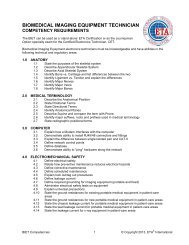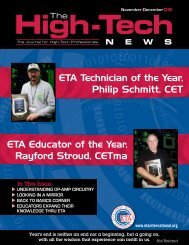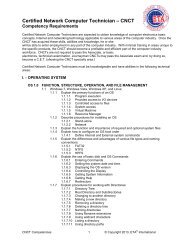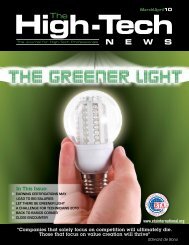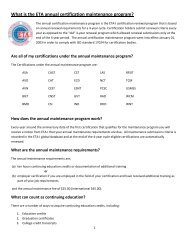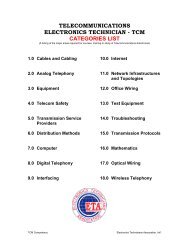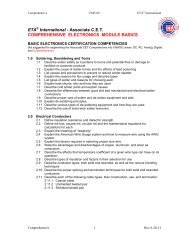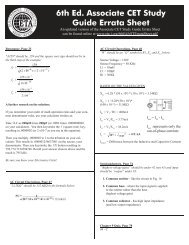Gaming & Vending Technician (GVT) - ETA International
Gaming & Vending Technician (GVT) - ETA International
Gaming & Vending Technician (GVT) - ETA International
You also want an ePaper? Increase the reach of your titles
YUMPU automatically turns print PDFs into web optimized ePapers that Google loves.
<strong>ETA</strong> ® <strong>International</strong> – <strong>Gaming</strong> and <strong>Vending</strong> <strong>Technician</strong><br />
2.2.1 Summarize Ohms Law<br />
2.2.2 Describe the following electronic measurements:<br />
2.2.2.1 Voltage<br />
2.2.2.2 Current<br />
2.2.2.3 Resistance<br />
2.2.3 Describe the basic Series circuit<br />
2.2.4 Describe the basic Parallel circuit<br />
2.2.5 Calculate current, voltage or resistance using Ohms Law in a Series Circuit<br />
2.3 Multimeter<br />
2.3.1 Explain multi-meter construction, components and usage<br />
2.3.2 Describe how to make a proper Ohms reading<br />
2.3.3 Describe the difference between a Continuity reading and an Ohm reading<br />
2.3.4 Describe how to make a proper DC and AC voltage reading<br />
2.3.5 Describe how to make a proper DC and AC amp reading<br />
2.4 Connectors<br />
2.4.1 Describe the two basic crimpers used on connectors<br />
3.0 BASIC ELECTRONICS CONCEPTS<br />
3.1 Electronic Components<br />
3.1.1 Identify the following electronic components and their usage<br />
3.1.1.1 Capacitor<br />
3.1.1.1.1 Describe the different types and the values assigned to them<br />
3.1.1.2 Resistor<br />
3.1.1.2.1 Identify a load resistor in a circuit<br />
3.1.1.2.2 Identify a voltage divider circuit<br />
3.1.1.2.3 Identify a pull up resistor<br />
3.1.1.2.4 Identify a dropping resistor<br />
3.1.1.3 Semi-conductors<br />
3.1.1.3.1 Describe the characteristics of a semi conductor<br />
3.1.1.3.2 Define the values of saturation for the two type semi conductors<br />
3.1.1.3.3 Describe the function of the following components, their terminals<br />
and polarities:<br />
3.1.1.3.3.1 Diodes<br />
3.1.1.3.3.2 LEDs<br />
3.1.1.3.3.3 Zener<br />
3.1.1.3.3.4 Transistor<br />
3.1.1.3.3.5 Darlington<br />
3.1.1.3.3.6 Diac<br />
3.1.1.3.3.7 SCR<br />
3.1.1.3.3.8 IC Voltage regulator<br />
3.1.1.3.3.9 Op Amp<br />
3.1.1.3.3.10 Full wave rectifier<br />
3.1.1.4 Digital Concepts<br />
3.1.1.4.1 List the different types of Logic Gates and their predominant input<br />
signals<br />
3.1.1.4.2 List the logic levels used<br />
3.1.1.4.3 Summarize IC chip power up configurations<br />
3.1.1.4.4 Explain how to determine leg configuration of an IC chip<br />
3.1.1.4.5 Define Flip Flop<br />
3.1.1.4.6 Define the operation and characteristics of a R/S and D Flip Flop<br />
3.1.1.4.7 Explain the different packaging used for multiple components<br />
4.0 COMPUTER HARDWARE, NETWORKING, AND DISPLAY TECHNOLOGIES<br />
4.1 Cabling<br />
4.1.1 Describe physical characteristics and useful properties of USB connectors<br />
4.1.2 Describe the two RJ45 cables<br />
<strong>GVT</strong> Competencies 2 © Copyright 2013, <strong>ETA</strong> ® <strong>International</strong>



